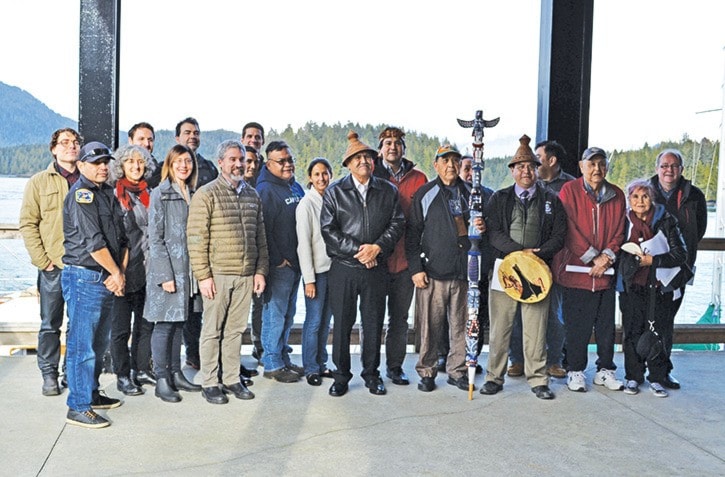NORA O’MALLEY
nora.omalley@westerlynews.ca
At an announcement ceremony held in Tofino last week, Ahousaht took their first step towards realizing a sustainable economic future for their people and hahoulthlee (territory).
The First Nation officially released a Land Use Vision plan that took over two years to develop.
Led by the Maaqutusiis Hahoutlhee Stewardship Society (MHSS) and backed by the Nature Conservancy Canada (TNC), the release builds on the $1.25 million economic partnership agreement between the provincial government and Ahousaht that was signed in August 2016.
Highlights of the economic development plan include prohibiting commercial logging, prohibiting mineral extraction, and preserving about 80 per cent of 170,903 hectares of land for cultural and natural purposes.
“The entire vision is about re-imaging how we are stewarding our territories resources and not accepting the status quo,” said Ahousaht hereditary representative Tyson Atleo.
“What we’ve been able to prove through the progress of the MHSS is that we don’t have to rely on the traditional resource economy to sustain the Ahousaht people.”
“That there are alternatives and that a diversified economy is a much stronger way forward,” he said.
Representatives from STAND.earth, Sierra Club B.C., Friends of Clayoquot Sound, and the Wilderness Committee attended the announcement ceremony to show solidarity for the proposal.
Forest conservationist Valerie Langer addressed the audience on behalf of Greenpeace and STAND.earth.
“These are the imperatives we have to deal with in the 21st century and this is the way that leadership looks when you deal with it,” she said.
“Ahousaht is one of the most beautiful and ecologically important places in the world. We are prepared to be there to support whenever you need us to move this forward. We are going to work in collaboration with the Nature Conservancy. Thank you so much for providing the leadership. This is a history that comes out of hundreds and hundreds of years of your work. In fact, my organization came into existence because of this place [Ahousaht],” said Langer.
In 1988, Langer took part in the protests that saved Meares Island’s old growth forest from logging. She said she was arrested to protect the territory on the same day as the late Chief Earl Maquinna George.
While Ahousaht’s Land Use Vision bans industrial forestry, Atleo said forest harvesting is not entirely prohibited.
“There is a community forestry designation. What we are looking at doing is re-envisioning how forestry happens here,” Atleo said.
About 12 per cent of their territory has been earmarked as a Forest Management Area. Managing this designated forest area according to an ecosystem-based set of principles that meet or exceed Clayoquot Sound Scientific Panel recommendations and Clayoquot Sound Watershed Plans is listed as the top objective.
Low impact tourism and recreation is continually listed as an allowable activity throughout the Land Use Vision document.
“I’m really proud to talk about the progress we’ve made in tourism. The Ahousaht people have developed our first commercial tourism operation in the Lone Cone campground and hostel. We employ all Ahousaht people and we invite tourists from around the world to see our culture and to be in our territories and to be welcomed by smiling Ahousaht faces,” said Atleo.
“We want to grow that vision. We want to grown the vision of sharing who we are as a people and our territories with the world in a wonderful and meaningful way.”
Atleo told the Westerly that the next critical step for moving the Ahousaht land vision forward will be to establish an endowment fund with their partners at the Nature Conservancy.
“Partnering is key that this process is supported financially over time,” he said.
